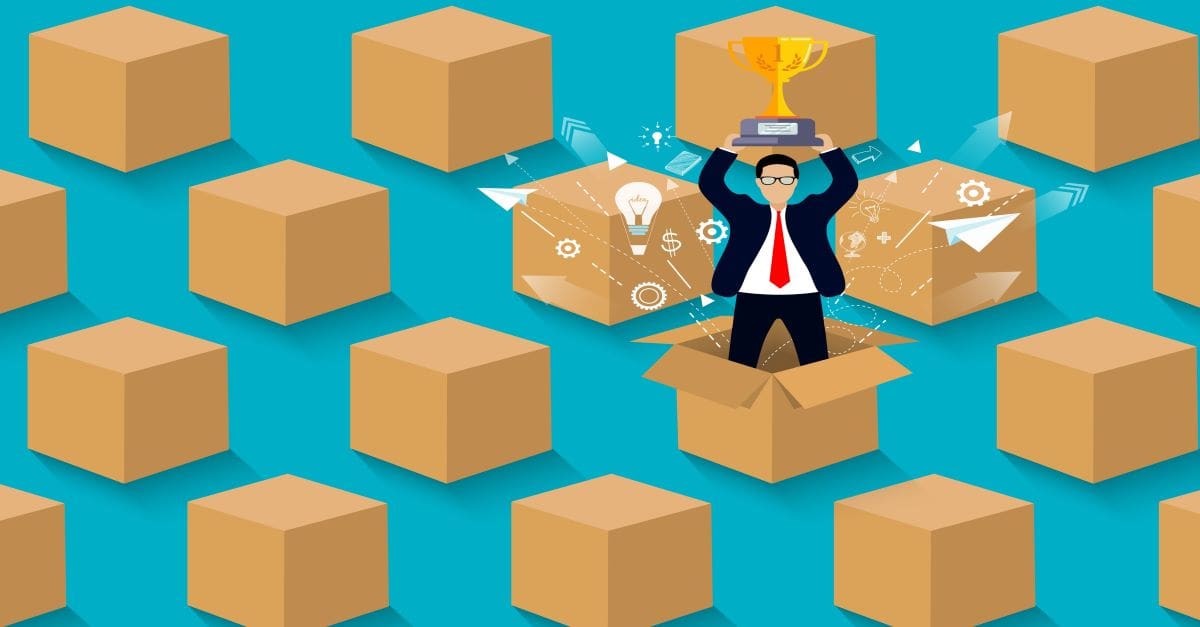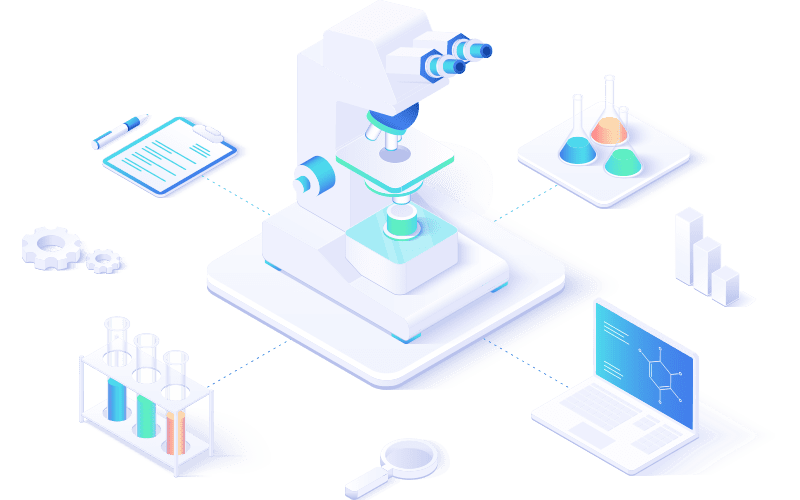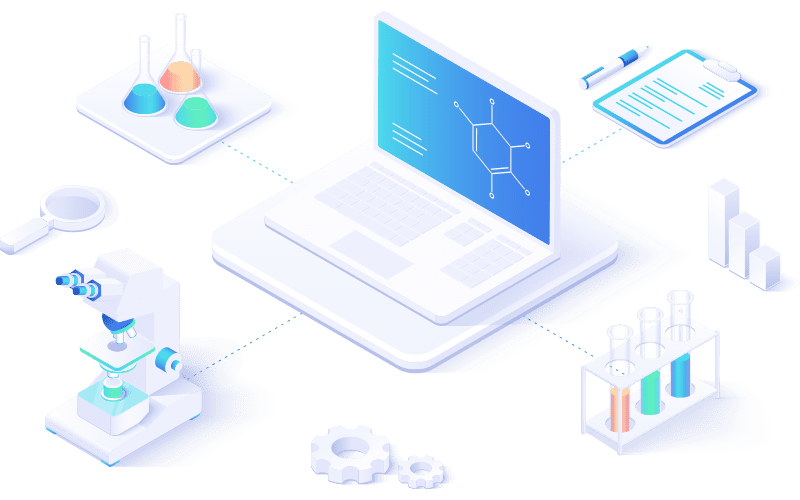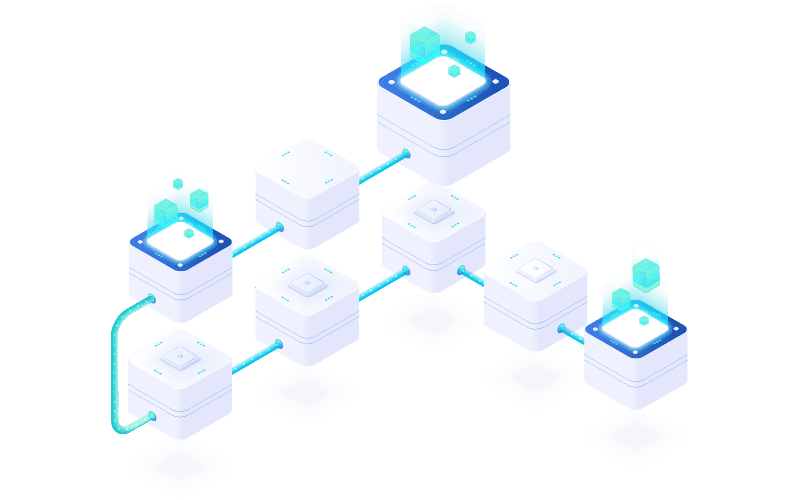
Implementing a laboratory information management system (LIMS) can streamline every aspect of your lab’s operations. From sample management to client communications, and from workflow efficiency to regulatory compliance, a LIMS automates processes to improve consistency, accuracy, and productivity.
But finding a LIMS that works with your lab’s unique combination of services and clients can be challenging. Changing processes to fit the quirks of a particular application only holds your lab back. It’s better to choose a LIMS that aligns with the way your lab works. When considering the broad range of LIMS offerings, you will find they fall into three general categories: off-the-shelf applications, user- configurable software, and customizable solutions.
Off-the-shelf applications can be affordable, ready-to-deploy options, but your lab must adjust to the software’s way of doing things. Configurable software is a little more flexible. Neither of these options, however, will grow and evolve with your lab over time.
This article will discuss the deep configurability and customizability of LabLynx’s ELab LIMS software platform and show how it provides the most flexible, scalable, and adaptable way to improve your lab’s performance.
1. Configurability in LabLynx LIMS solutions
LabLynx LIMS solutions start with industry-specific configurations that deliver the benefits of off-the-shelf applications. Labs can get up and running quickly with all standards, workflows, reports, and other needed features.
Unlike rigid off-the-shelf software, LabLynx’s base configurations form the foundation for a LIMS software solution specific to your lab. Deep user configurability gives you responsive control over your LIMS.
1.1 Organization structure
As your lab evolves, you may need to modify your LIMS to reflect changes in your organization’s structure. Here are a few ways your staff can keep your LabLynx LIMS aligned with these changes.
1.1.1 Acquisitions
When you acquire another lab, you will need to integrate the new operations into your LIMS. Although not part of the original implementation, everything you need exists in the LabLynx ELab LIMS platform.
Through simple administrative screens, you can add the new operation’s personnel, services, tests, and workflows into your LIMS.
1.1.2 Departmental structure
If your growing business requires a more structured organization, you can adapt your LabLynx LIMS to a multi- department operation. Your administrators can create staff and supervisory roles while assigning workflows, instruments, and other lab attributes to the appropriate department. Communications within your lab remain as streamlined as before since everything flows through your LIMS.
1.1.3 Geographic expansions
Expanding to multiple locations lets your lab reach new markets and improve customer service. The LabLynx ELab LIMS allows administrators to create location-specific configurations with dedicated workflows and other capabilities. Each site only sees the features they need.
1.1.4 Management structure
A growing lab requires a growing team with a more complex management structure. You can create groups of managers, supervisors, analysts, and technicians for your testing services. Plus, you can create dedicated management structures for your front-end and administrative staff.
1.2 Business relationships
Laboratories rely on networks of third-party relationships. A LabLynx ELab LIMS solution does far more than store contracts and contact information.
1.2.1 Clients
You can set up your LIMS to handle many different types of clients. Internal labs can take orders from other teams within the organization. Public-facing labs can take orders from individuals. In each case, you can configure your LIMS with client-specific workflows, parameters, and reports.
1.2.2 Suppliers
You can automate your lab’s inventory management by tracking reagents and other consumables in your LIMS. Notifications will alert your staff as inventory reaches pre-defined thresholds. Or you can let your LabLynx LIMS compile supplier information to generate purchase orders automatically.
1.2.3 Contractors and consultants
Supplementing your lab’s employees with outside contractors can add expertise and improve throughput. Your LIMS will streamline the management of these business relationships. Additionally, you can make your lab more secure. Rather than giving outsiders open access to your lab’s resources, role-based controls limit third-party access to essential LIMS functions.
1.2.4 Third-party laboratories
Have your LIMS track samples sent to outside labs for specialized testing or during surges in demand. Your LIMS will automatically associate the returned results with the appropriate client order.
1.2.5 Government regulators
LabLynx’s base LIMS configurations include your industry’s common local, state, tribal, and federal regulatory filings. Your administrators can easily update these reports as rules as reporting requirements change.
1.3 Testing process
A LIMS’ core benefit is the improvement in testing efficiency and accuracy. The LabLynx LIMS lets administrators configure all aspects of the testing process, from order management to report generation.
1.3.1 Order management
Your ELab LIMS automatically populates simple order entry screens with client details, quoted pricing, and other information. Built-in validation makes order entry more accurate. Notification rules ensure rapid turnaround times by alerting staff of pending milestones or overdue activity.
1.3.2 Sample collection
You can set up your LIMS to enrich data about each sample by defining collection routes, locations, collection sites, environmental conditions, and more. Whether your customers collect the samples or you offer collection services, providing barcoded labels makes sample receiving more efficient.
1.3.3 Sample management and tracking
Know where every sample is from when it arrives in the lab through disposal. You can configure your lab’s storage locations by room, cabinet, and shelf. Create status reports, alerts, and notifications to ensure samples are always where they should be.
1.3.4 Instrument management
Configuring instruments in your LIMS reduces analytical errors by automating the creation of instrument run lists. Tracking maintenance, repair, and calibration schedules in your LIMS minimizes disruptions to your lab’s testing process.
1.3.5 Standards and workflows
LabLynx’s industry-specific base configurations include commonly-used standards and workflows. Simple interfaces let your staff modify workflows or create processes to meet new requirements.
1.3.6 Report creation and routing
LabLynx’s laboratory informatics solutions let your staff design templates that improve report accuracy and help reduce turnaround times. Eliminate transcription errors by populating, validating, and formatting data into report templates directly from your LIMS. Once your analysts’ work is complete, your LIMS will automatically route the report for approval before queueing the final report for release.
1.4 Laboratory management
The benefits of a LIMS extend beyond the testing process to almost every aspect of a laboratory’s operations. Your staff can configure a LabLynx ELab LIMS solution to support a variety of business functions.
1.4.1 Training and certification
Set up your LIMS to track the status of staff training and professional certifications. You can schedule training sessions in each employee’s LIMS-based calendar. Your LIMS also serves as a central repository for standard operating procedures (SOPs) and in-house training materials.
1.4.2 Quality control and assurance
LabLynx LIMS solutions include tools for managing your lab’s operations. Your staff can create control charts and reports to monitor testing, instrument performance, and other metrics.
1.4.3 Audits and compliance
All laboratory performance data resides in your LabLynx ELab LIMS solution. Easy reporting tools let you investigate non-conforming events or respond to auditor requests. As a result, your LIMS helps streamline your compliance efforts, whether with standards such as ISO/IEC 17025 or regulations such as HIPAA.
2. Extensibility with cloud applications
Laboratories often need information management capabilities beyond what traditional LIMS software offers. Adding those capabilities traditionally requires a different vendor’s application, which may not work perfectly with your LIMS. LabLynx cloud applications deliver new capabilities without risking compatibility issues. By integrating with your LIMS, these cloud applications can enhance your customers’ experience, extend your lab’s capabilities, and improve internal productivity.
2.1 Web portals
Improve your lab’s customer experience by letting customers access services from anywhere, at any time and on any device. Web portals integrated with your LIMS allow customers to interact with your lab on their schedule rather than waiting for office hours.
LabLynx’s myLabCare is a general B2B portal, while getTested is a consumer-oriented platform primarily used by healthcare laboratories. Whether consumers or businesses, your customers’ information remains secure and private thanks to end-to-end encryption between the portal and their devices.
During implementation, LabLynx aligns your portal platforms with your branding and enables a variety of services.
2.1.1 Web-based order entry
Portals let customers enter their own orders directly into your LIMS. Validation rules improve order accuracy. Meanwhile, your staff can stop worrying about illegible paperwork or fixing transcription errors.
2.1.2 Sample barcode label distribution
When customers who collect their own samples place an order, your LIMS will post an automatically- generated barcode label file to the customer’s portal page. Customers can print the label and apply it to the sample at the point of collection. Distributing sample barcode labels through your portal reduces the risk of mislabeled samples and streamlines your sample lab’s receiving processes.
2.1.3 Order progress and report distribution
Your portal can let customers monitor their orders as samples reach key testing milestones. Once the final report is ready, your LIMS will post it to the customer’s portal page. They can opt-in to email or SMS notifications so they know when their order is complete.
2.2 ELab Notes
LabLynx’s electronic laboratory notebook (ELN) application ELab Notes lets your LIMS fully document your projects with notes, images, and more. Integrating your ELN and LIMS improves communications by giving teams a shared source for project information. ELab Notes uses the security features of your LIMS to make lab data accessible while controlling access.
2.3 LabDrive
LabLynx’s cloud productivity system LabDrive includes native spreadsheet, document, and presentation creation tools. LabDrive’s LIMS integration optimizes it for laboratory use. Bringing data into documents and spreadsheets becomes much simpler and more reliable when you can pull it directly from the LIMS.
3. Integrations with third-party systems
Integrating with third-party systems is often necessary to meet the requirements of a lab’s parent organization, improve laboratory performance, and comply with regulations. LabLynx engineers have addressed just about every integration use case.
3.1 Laboratory systems
LabLynx’s LabVia integration solution connects your laboratory’s instruments, automation systems, environmental sensors, and other systems to your LIMS. Consolidating data flows within your LIMS improves productivity by freeing staff from tedious data management tasks. Simultaneously, LabVia eliminates the most common sources of manual data handling errors.
3.2 Enterprise systems
Integrating your LIMS with enterprise-wide systems enhances your lab’s support for the larger organization. For example, manufacturing labs can exchange data with quality control systems on the factory floor. LabLynx engineers work with your IT department to set up APIs, file transfers, or other enterprise integration methods for your LIMS.
3.3 External reporting systems
Our clients often submit reports to a customer’s vendor management system or a regulator’s database. Manually filing reports opens the risk of delays. These third-party systems use well-established interfaces that let you file reports automatically. LabLynx engineers can integrate your ELab LIMS with these systems to improve your lab’s customer service and compliance.
4. Customization of LIMS software
Configurability, application extensions, and system integrations bring your LabLynx LIMS into near- perfect alignment with the way your lab works. In our experience, there is always something else to improve. Whether tweaking a process or creating a new capability, LabLynx developers tailor LIMS code for almost every client.
4.1 Cooperative development process
During your initial conversations, LabLynx identifies which needs go beyond the configuration of existing LIMS features. Together, we build a development schedule and budget to add customized features. LabLynx developers modify code to make your LIMS work perfectly in your lab. Future updates to the core LIMS platform become part of your tailored solution. LabLynx provides full support for your customizations, and our support team is ready to answer your employees’ questions.
4.2 Enterprise license
Cloud-based solutions have become accepted business practices but are not always appropriate for every client. Government agencies and businesses in highly regulated industries may need more control over their data security. These clients can self-host a LabLynx LIMS and develop their own customizations with an Enterprise license.
The sciForge development platform gives self-hosting clients the tools they need to customize their LIMS. Design tools let clients’ developers create custom screens, data fields, integrations, and other features specific to their lab’s needs. Project management and validation resources help developers efficiently create their custom solutions.
LabLynx support falls under the Enterprise license’s maintenance agreement and depends on the degree of visibility LabLynx engineers have into the client’s changes.
5. Creating a LIMS for your lab
Every LabLynx client engagement begins with two-way conversations. As the LabLynx team learns how your lab works today and where you see it going in the future, your team learns what a LabLynx LIMS makes possible.
5.1 Initial deployment
Your initial implementation can be quite simple and ready to deploy in less than a month. Clients will take this path to get immediate improvements in efficiency and accuracy.
LabLynx starts by aligning an industry-specific base version to your lab while replacing paperwork and spreadsheets with LIMS-based processes. Taking this simple step improves productivity as your staff spends less time handling data and chasing down testing errors.
Your LIMS administrators learn how to use our simple LIMS configuration tools during the deployment process. Empowering your staff to change the LIMS makes your lab more responsive to new client needs.
5.2 Improving internal performance
Meanwhile, LabLynx works with you to develop a customization roadmap that takes your lab even further. For example, the LabLynx clients in healthcare and other tightly regulated industries commonly request systems for demonstrating regulatory compliance.
These rules require careful tracking throughout the testing process, tracing who handles samples, how workflows are executed, what equipment and solutions are used, and more. They also set data integrity standards that prevent changes to test results without formal justification.
LabLynx will customize the ELab LIMS platform to provide these clients with the systems to create auditable records of everything that happens to each sample. LabLynx reporting tools make these records easily accessible when investigating non-conformance events. They also let clients respond faster to an auditor’s requests, making accreditation easier to achieve.
5.3 Improving customer experiences
Earlier, we discussed how web portals improve customer interactions with your lab. Another way to make your lab more accessible and pleasant to do business with is by tailoring the customer experience with our report design tool.
LabVista Report Designer lets your LIMS administrators create report templates specific to your lab’s services and customers. Using graphic design best practices, you can make it easier for your customers to interpret test results.
Integration with your LIMS ensures error-free transfers of data into each report. Data fields will automatically turn the data into a readable format. You can also write scripts to sort results or create summary reports for large orders.
Once a report is complete, your LIMS can publish it as a .pdf or .html for posting to your web portal. Excel, *.txt, and other electronic formats are available to meet any customer’s requests.
6. In conclusion…
Changing the way your lab works to fit the rigid structure of an off-the-shelf LIMS does little to improve your lab’s performance. Implementing a LIMS that fits your lab’s unique capabilities will elevate performance and customer service.
Configurability, extensibility, integrations, and customizations ensure LabLynx clients get the perfect LIMS solution for their labs, both today and into the future.
Contact LabLynx today by emailing sales@lablynx.com or visit our website, www.lablynx.com, to learn more about how we can provide and support a LabLynx ELab LIMS that best fits the way your lab works.
Accelerate Your Lab's Success & Experience LabLynx
"*" indicates required fields
Explore the LabLynx Suites

LIMS Suite
Seamless Sample and Workflow Management
The LabLynx LIMS Suite empowers laboratories with the tools needed to manage samples, workflows, compliance, and more in one centralized system. It’s the backbone for labs seeking efficient, reliable, and scalable management solutions.

ELN Suite
The LabLynx ELN Suite offers a modern approach to managing lab data and experiments. With its secure, intuitive platform, your team can record, store, and collaborate effortlessly, supporting innovation every step of the way.

Lab Automation
Automate for Efficiency and Growth
Streamline operations and boost productivity with the LabLynx Lab Automation Suite. Designed for labs ready to embrace advanced automation, this suite integrates systems, instruments, and workflows to deliver efficiency at scale.
